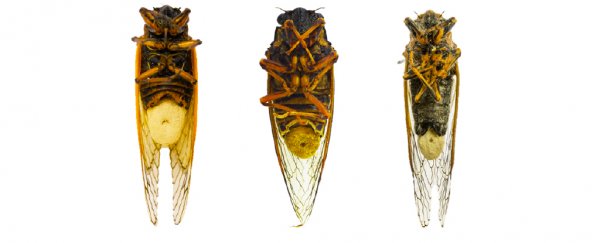In latest gruesome nature news, scientists have discovered new details on a fungus that compels its cicada hosts to mate long after their genitals have gone and their bodies have turned into what one researcher colourfully describes as 'flying salt shakers of death'.
The fungus is called Massospora cicadina, and its effects read like an abstinence campaign for cicadas. But it also appears that it affects the sex-crazed cicadas by sending them on one heck of a drug trip.
A team of researchers from the US has analysed the biochemistry in periodical cicada populations infected with pathogenic fungi, finding evidence of a plant-associated amphetamine and a psychoactive chemical found in magic mushrooms.
Now, this really shouldn't need to be said. But we feel obligated to say it anyway. This is in no way to suggest cicada fungal pox should be considered for your next high.
"These psychoactive compounds were just two of less than 1,000 compounds found in these cicadas," says West Virginia University forest pathologist Matt Kasson.
"Yes, they are notable, but there are other compounds that might be harmful to humans. I wouldn't take that risk."
The way the pathogenic fungal species produce the molecules could point the way to new pharmaceuticals, though, since the enzymes typically responsible for the compounds are strangely absent in this instance.
Spore-spreading horror shows like M. cicadina have been in the research books for more than a century, with recent investigations further fleshing out the processes they use to complete their life cycle.
Today we understand that a small fraction of cicadas are first infected by spores on their body and in the soil as they emerge as adults.
These can then develop into full-blown Stage II infections, where the fungus blooms inside their bodies and turns them into mini crop dusters of doom.
To increase chances of infecting another cicada, the fungus has a few tricks up its sleeve. One is to encourage male hosts to flap their wings in a rather feminine manner, attracting other males to stop by for a quick snuggle.
With the deed done, the spore-dusted suitor departs to find other mates, spreading the disease as it goes.
As if that's not enough, the fungus turns them into rampant sex-bots of destruction. Even as the cicada bodies turn mouldy and start losing parts – including bits of their abdomen and their genitals – they don't slow down.
"Infected adults maintain or accelerate normal host activity during sporulation, enabling rapid and widespread dispersal prior to host death," says Kasson.
While a number of fungi have evolved clever ways to hijack their host's behaviours to help them get around, those of the order M. cicadina belongs to haven't received the same level of scrutiny.
By pulling apart the diverse array of metabolites inside wild infected insects, the researchers have now added another layer of detail to the fungus's method for hostile takeover.
In four cicadas infected with M. cicadina they found signs of a plant-derived alkaloid called cathinone, a compound similar to ephedrine.
It's possible that the stimulant could have evolved in the fungus to keep their hosts' appetites down and give them a boost to get them through those long days of plague orgies.
What's especially interesting is that this could be the first example of a cathinone to be produced inside something other than a plant.
Another fungal pathogen called M. levispora was also associated with raised levels of a tryptamine called psilocybin - the psychedelic compound in magic mushrooms.
This one might not come as much of a surprise. There's good reason to suspect the chemical evolved in fungi as a way to suppress insect appetites, changing their behaviour in a dissuasive fashion.
Finding these mind-altering substances inside the infected insects is one thing. The mystery is how they got there, especially without hints of the usual intermediate metabolites, or even expected genes.
The next step is to dig into the fungal genomes and see how they express themselves inside their hosts.
"We anticipate these discoveries will foster a renewed interest in early diverging fungi and their pharmacologically important secondary metabolites, which may serve as the next frontier for novel drug discovery," says Kasson.
Please don't make us remind you to leave the experimenting to the professionals.
This research was published in Fungal Ecology.
